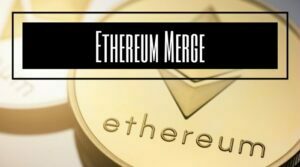The Ethereum merge is a transition from proof-of-work (PoW) to proof-of-stake (PoS). It is called the “The Merge” because the beacon chain will merge with the existing Ethereum mainnet chain.
Ethereum Merge Date
The Ethereum merge date has been delayed until some time in July, August, or September 2022. The Ethereum merge was targeted for June 2022, however no exact date has ever been set. The merge update is an important step towards a proof-of-stake consensus algorithm.
“It won’t be June, but likely in the few months after,” Tim Beiko, an Ethereum Foundation developer, said yesterday on Twitter. “No firm date yet, but we’re definitely in the final chapter of PoW on Ethereum.”

What’s Happening
The Merge is the Ethereum’s transition from proof-of-work (PoW) to proof-of-stake (PoS). PoS: Blockchain consensus comes from people (stakers) who lock up their Ethereum. PoW: Consensus for the blockchain comes from people (miners) who secure the network with computing power.
The ETH Merge is the full transition of Ethereum away from Proof-of-Work (PoW) to Proof-of-Stake (PoS).
A lot of the groundwork needed to execute the Merge successfully has already been done.
- The Beacon chain already exists
- There’s already a warm-up fork
- PoS already has light client friendliness
Why The Merge is Happening
Ethereum has a lot of problems, and has worked towards solving the blockchain trilemma:
- Security
- Decentralization
- Scalability
- PoS eliminates the need for expensive equipment or cheap electricity
Blockchains so far have had to compromise on at least one of these characteristics. While it doesn’t make Ethereum perfect, it helps.
Ethereum Merge Benefits
- ETH Staking APY Increases by directing transaction fees away from hardware miners and towards ETH stakers. Staking APY is expected to go from 4% to about 9-12%.
- The launch of L2 native tokens will fuel a flurry of activity as users and investors look to scoop up ownership in these ecosystems, generating more transaction revenue for Ethereum. Currently none of the “Big 4” Layer 2s—Arbitrum, Optimism, StarkNet, and zkSync—have launched a token yet.
- New ETH issuance is reduced by 90%. Ethereum will undergo a 90% cut of daily emissions from 12,000 $ETH a day to 1,280 $ETH. The yearly $ETH inflation will decrease from 4.3% to 0.43%.
- Increased rewards for PoS validators. Over 10.65M ETH staked in the Beacon Chain by 300k+ validators is currently earning 4.7% APR. These rewards will increase 2–3x to ~10–15% post-merge.
- ETH goes green — ETH’s energy consumption will drop by 99.95% with the transition to PoS.
Ethereum Merge Cons or Neutral Changes
- The Merge will not lower transaction fees. L2s and EIP-4844 will take care of that.
- While the Merge is bullish, there are concerns being voiced by Ethereum devs about the direction the project is going in. Some devs believe, Ethereum is not going in a ‘clean direction’ and is increasing the complexity of the blockchain network.
How The Ethereum 2.0 Upgrade Works
- Decentralization/Security: The Merge requires a minimum amount of nodes & makes it easier to run a node
- Sustainability: PoS uses roughly 99% less energy than PoW
- Scalability: Opens the door for sharding, which may someday allow for 100k TPS
To run a node you need to stake 32 ETH, and you have to lock up ETH until the Merge. After the Merge, rewards will not go to miners, and go to stakers instead.
How to Benefit from the Merge
- Stack ETH
- Stake ETH
- Have at least 32 ETH or use protocols to stake ETH to a validator
- Deposit ETH e.g. RocketPool, Lido, StaFi
- The protocol stakes the ETH to a validator
- Receive a liquid (sellable) wrapper representing a right to that staked ETH
- The staked ETH accrues interest
- Use the liquid wrapper on DeFi
How Does ETH Become Deflationary?
The EIP-1559 upgrade began to burn some of the tx fees paid to miners. This created a small deflationary pressure for ETH. With the Merge, rewards paid out to validators will be reduced by roughly 90%. Now: ETH burned > ETH issued.
Sharding
Shards are not planned until 2023, but they make Ethereum faster and less computation-intensive.
History of Ethereum Upgrades
2021
Arrow Glacier
The Arrow Glacier network upgrade pushed back the difficulty bomb by several months. This is the only change introduced in this upgrade, and is similar in nature to the Muir Glacier upgrade. Similar changes have been performed on the Byzantium, Constantinople and London network upgrades.
Altair
The Altair upgrade was the first scheduled upgrade for the Beacon Chain. It added support for “sync committees”—enabling light clients, and bringing validator inactivity and slashing penalties up to their full values.
London
The London upgrade introduced EIP-1559, which reformed the transaction fee market, along with changes to how gas refunds are handled and the Ice Age schedule.
Berlin
The Berlin upgrade optimized gas cost for certain EVM actions, and increases support for multiple transaction types.
2020
Beacon Chain Genesis
The Beacon Chain needed 16384 deposits of 32 staked ETH to ship securely. This happened on November 27, meaning the Beacon Chain started producing blocks on December 1, 2020. This is an important first step in achieving the Ethereum vision.
Beacon Chain
The staking deposit contract introduced staking to the Ethereum ecosystem. Although a Mainnet contract, it had a direct impact on the timeline for launching the Beacon Chain, an important Ethereum upgrade.
Muir Glacier
The Muir Glacier fork introduced a delay to the difficulty bomb. Increases in block difficulty of the proof-of-work consensus mechanism threatened to degrade the usability of Ethereum by increasing wait times for sending transactions and using dapps.
2019
Istanbul
The Istanbul fork: Optimized the gas cost of certain actions in the EVM. Improved denial-of-service attack resilience; Made Layer 2 scaling solutions based on SNARKs and STARKs more performant; Enabled Ethereum and Zcash to interoperate; Allowed contracts to introduce more creative functions.
Constantinople
The Constantinople fork: Ensured the blockchain didn’t freeze before proof-of-stake was implemented; Optimized the gas cost of certain actions in the EVM; Added the ability to interact with addresses that haven’t been created yet.
2017
Byzantium
The Byzantium fork: Reduced block mining rewards from 5 to 3 ETH; Delayed the difficulty bomb by a year; Added ability to make non-state-changing calls to other contracts; Added certain cryptography methods to allow for layer 2 scaling.
2016
Spurious Dragon
The Spurious Dragon fork was the second response to the denial of service (DoS) attacks on the network (September/October 2016)
Including:
- Tuning opcode pricing to prevent future attacks on the network.
- Enabling “debloat” of the blockchain state.
- Adding replay attack protection.
Tangerine Whistle
The Tangerine Whistle fork was the first response to the denial of service (DoS) attacks on the network (September/October 2016) including:
- Addressing urgent network health issues concerning underpriced operation codes.
DAO Fork
The DAO fork was in response to the 2016 DAO attack where an insecure DAO contract was drained of over 3.6 million ETH in a hack. The fork moved the funds from the faulty contract to a new contract with a single function: withdraw. Anyone who lost funds could withdraw 1 ETH for every 100 DAO tokens in their wallets.
This course of action was voted on by the Ethereum community. Any ETH holder was able to vote via a transaction on a voting platform. The decision to fork reached over 85% of the votes.
Some miners refused to fork because the DAO incident wasn’t a defect in the protocol. They went on to form Ethereum Classic.
Homestead
The Homestead fork that looked to the future. It included several protocol changes and a networking change that gave Ethereum the ability to do further network upgrades.
2015
Frontier Thawing
The frontier thawing fork lifted the 5,000 gas limit per block and set the default gas price to 51 gwei. This allowed for transactions – transactions require 21,000 gas.
Frontier
Frontier was a live, but barebone implementation of the Ethereum project. It followed the successful Olympic testing phase. It was intended for technical users, specifically developers. Blocks had a gas limit of 5,000. This ‘thawing’ period enabled miners to start their operations and for early adopters to install their clients without having to ‘rush’.
Ether Sale
Ether officially went on sale for 42 days. You could buy it with BTC.
Yellowpaper Released
The Yellow Paper, authored by Dr. Gavin Wood, is a technical definition of the Ethereum protocol.
2014
Whitepaper Released
The introductory paper, published in 2013 by Vitalik Buterin, the founder of Ethereum, before the project’s launch in 2015.
Joe Wallace has covered real estate and financial topics, including crypto and NFTs since 1995. His work has appeared on Veteran.com, The Pentagon Channel, ABC and many print and online publications. Joe is a 13-year veteran of the United States Air Force and a former reporter for Air Force Television News.


